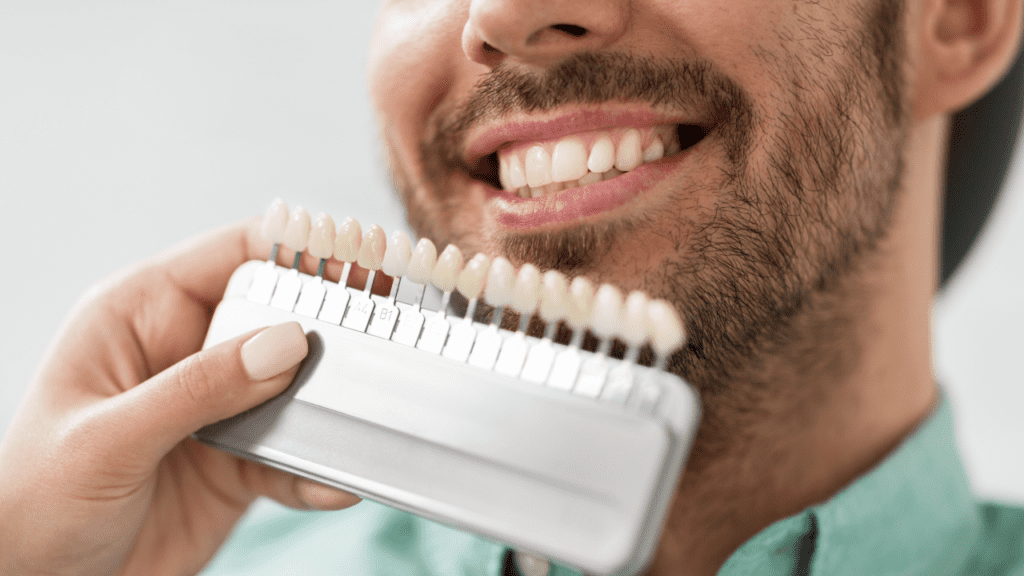In the quest for a bright, confident smile, many people turn to various teeth whitening methods. One popular and cost-effective option is using baking soda. This humble kitchen ingredient has garnered attention as a natural teeth whitener, promising to lift stains and leave teeth gleaming. But how effective is it really? Let’s dive into the science and explore the ins and outs of whitening teeth with baking soda.
How Does Baking Soda Whiten Teeth
The secret behind baking soda’s teeth whitening prowess lies in its chemical composition and physical properties. Baking soda, also known as sodium bicarbonate, is an alkaline compound that, when mixed with water, creates a slightly abrasive paste. This gentle abrasiveness allows baking soda to scrub away surface stains from the teeth, restoring their natural shine.
Additionally, baking soda creates an alkaline environment in the mouth, which inhibits the growth of certain bacteria responsible for plaque formation and yellowing of teeth. The alkaline nature of baking soda helps neutralize the acids produced by these bacteria, reducing the risk of enamel erosion and tooth decay.
How Can I Whiten My Teeth with Baking Soda?
Achieving a brighter smile with baking soda is a straightforward process that requires a few simple steps. Follow this guide to ensure safe and effective teeth whitening:
Step 1: Gather Your Supplies
Before you begin, gather the necessary supplies: baking soda, a toothbrush, and water. Ensure that the baking soda is fresh and free from any impurities.
Step 2: Create the Baking Soda Paste
Mix a small amount of baking soda with water in a clean container. Aim for a thick but spreadable consistency, ensuring that the paste adheres to your toothbrush without dripping.
Step 3: Apply the Baking Soda Paste
Scoop up the baking soda paste with your toothbrush and apply it to the bristles. It’s essential to use only a small amount, as excessive application can lead to unnecessary abrasion on your teeth.
Step 4: Gentle Brushing
Gently brush your teeth using the baking soda paste. Make sure to cover all tooth surfaces, paying special attention to areas with visible stains or discoloration. Use small, circular motions and avoid scrubbing too hard, as aggressive brushing can harm your enamel.
Step 5: Rinse Thoroughly
After two minutes of brushing, thoroughly rinse your mouth with water to remove any traces of baking soda. Take care not to swallow the paste.
Step 6: Regular Use
Consistency is key to achieving noticeable results. For optimal whitening effects, repeat this routine two to three times a week for several weeks. Remember that baking soda’s whitening effects are gradual, so patience and dedication are essential.
How Long Does It Take for Baking Soda to Whiten Teeth?
The effectiveness of baking soda as a teeth whitener varies from person to person. Some individuals may notice a difference after a few weeks of consistent use, while others may require more time. It’s essential to remember that baking soda’s whitening effects are gradual and may not be as potent as professional teeth whitening treatments. If you’re seeking rapid results for a special occasion, baking soda may not be the most suitable choice.
Is It OK to Brush Your Teeth with Just Baking Soda?
While it’s generally considered safe to use baking soda occasionally as a teeth whitening aid, relying solely on it for brushing is not recommended. Baking soda lacks fluoride, a vital mineral that helps strengthen teeth and prevent tooth decay. Prolonged and exclusive use of baking soda for brushing may leave your teeth vulnerable to cavities and other dental problems. Striking a balance between using regular fluoride toothpaste and baking soda for whitening purposes is the way to go.
How Often Should I Use Baking Soda on My Teeth to Whiten Them?
Moderation is crucial when using baking soda as a teeth whitener. Overuse can lead to enamel erosion and tooth sensitivity, which can be both uncomfortable and detrimental to your oral health. As a general rule, stick to a schedule of using baking soda paste two to three times a week. If you experience any discomfort or sensitivity while using it, consider reducing the frequency or discontinuing its use altogether.
What Are the Pros and Cons of Using Baking Soda to Whiten Teeth?
Like any dental method, using baking soda for teeth whitening comes with its own set of advantages and disadvantages:
The Pros
Cost-Effectiveness: Baking soda is an inexpensive alternative to commercial teeth whitening products or professional treatments. It offers a budget-friendly option for those looking to brighten their smile without breaking the bank.
Readily Available: Baking soda is a common household item, making it easily accessible for anyone interested in trying it as a teeth whitening remedy.
Gentle Stain Removal: The gentle abrasive action of baking soda helps remove surface stains effectively, making it a viable option for brightening teeth.
The Cons
Enamel Erosion: One of the primary concerns with using baking soda for teeth whitening is its abrasive nature. Continuous and aggressive use of baking soda can wear down the enamel over time, leading to tooth sensitivity and potential long-term damage.
Limited Whitening Power: Baking soda may not be as effective in removing deep-set stains or providing significant whitening compared to professional treatments.
Lack of Fluoride: As mentioned earlier, baking soda lacks fluoride, which is crucial for strengthening tooth enamel and protecting against cavities. Relying solely on baking soda for brushing may compromise your overall dental health.
Why Do Dentists Not Recommend Baking Soda?
Dentists, as oral health professionals, generally do not endorse baking soda as a primary teeth whitening method due to several reasons:
Enamel Erosion
Baking soda’s abrasive nature can lead to enamel erosion, leaving teeth vulnerable to sensitivity and decay. Once enamel is eroded, it cannot be naturally restored, making its preservation a top priority.
Limited Whitening Effect
While baking soda can help remove surface stains, its whitening power is relatively mild compared to professional treatments. Dentists typically recommend more potent and predictable options for those seeking significant teeth whitening results.
Lack of Fluoride
Baking soda lacks fluoride, a mineral essential for maintaining strong teeth and preventing cavities. Fluoride is a key component in most commercial toothpaste and is an integral part of oral health care.
Potential for Misuse
Without proper guidance, individuals may overuse baking soda or use it incorrectly, leading to adverse effects on their oral health.
While baking soda can be used occasionally for teeth whitening, it should not replace your regular dental care routine. Dentists advocate for brushing with fluoride toothpaste, flossing, and visiting your dentist regularly for check-ups and professional cleanings to maintain optimal oral health.
What Can I Use Instead of Baking Soda to Whiten My Teeth?
If you’re looking for alternatives to baking soda for teeth whitening, consider the following options:
Hydrogen Peroxide
Diluted hydrogen peroxide can be used as a mouthwash to help whiten teeth. It has mild bleaching properties that may aid in stain removal. However, it’s essential to use it cautiously to avoid gum and tooth sensitivity. Accidental swallowing can cause an upset stomach, nausea, and vomiting.
Activated Charcoal
This trendy option claims to absorb surface stains and toxins, offering a natural way to brighten teeth. Research on its effectiveness is still limited, but some individuals find it beneficial. It is typically not recommended by dentists because it is not approved by the American Dental Association (ADA) and can be damaging to tooth enamel.
Fruits and Vegetables
Some fruits and vegetables, such as strawberries and pineapple, contain natural enzymes that may help break down stains and promote a brighter smile. However, their whitening effects may be modest compared to other methods.
Conclusion
Using baking soda as a teeth whitener can be an accessible and cost-effective option for those seeking a brighter smile. Its gentle abrasive properties and alkaline nature can help remove surface stains and improve the overall appearance of teeth. However, it’s crucial to use baking soda with caution, as overuse can lead to enamel erosion and tooth sensitivity.
Related Articles
Baking Soda Toothpaste: Does it really work?
How Much Does Teeth Whitening Cost? The Complete Guide
How to Use Crest White Strips The Right Way
Erica Anand is a certified dental expert. She holds a BA in Chemistry and a Doctorate of Dental Surgery from Stony Brook University. After completing a two-year pediatric dentistry program, she now runs a private practice focusing on preventive dentistry and is a member of the American Association of Dental Consultants.
Marcus Ramsey has been a professional writer for over seven years. He has talked about and produced content for industries like Dentistry, Healthcare, and more.






